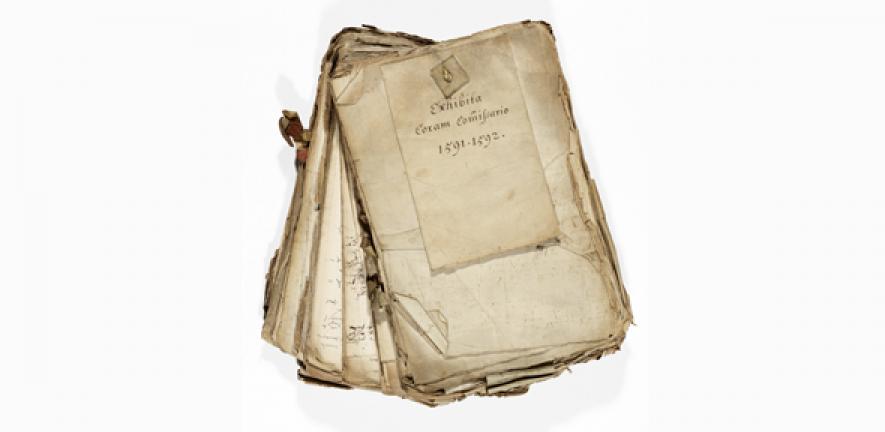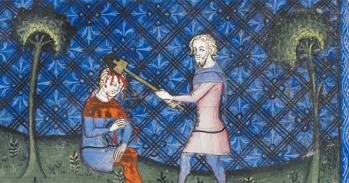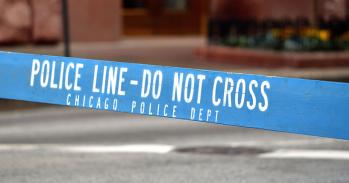
Adultery, libel, bribery, attempted murder: Cambridge University’s criminal underbelly has been exposed after painstaking research on its Vice-Chancellor’s Court records from the sixteenth and seventeenth centuries.
Adultery, libel, bribery, attempted murder: Cambridge University’s criminal underbelly has been exposed after painstaking research on its Vice-Chancellor’s Court records from the sixteenth and seventeenth centuries.
The papers include allegations, questions for witnesses, personal statements and letters, across the entire range of the court’s activity, the litigants’ voices rising off the page.
Jacky Cox
At Cambridge University Library, thousands of pages chronicling the crimes and misdemeanours of staff, students and townspeople connected to the university are being catalogued and summarised for the first time by university archivist Jacky Cox.
She said: “The court records provide a vivid insight into the social and economic history of Cambridge, beyond the academic life of the University, as the inhabitants of this small market town, town alongside gown, lived and died, traded, worshipped, fell out and made up under the auspices of the University authorities.”
Technically the Chancellor's Court, but presided over by the Vice-Chancellor from the sixteenth century, the court accrued wide-ranging civil, criminal and ecclesiastical powers from successive monarchs to try cases affecting University members and other ‘privileged persons’ (townspeople providing any service to a University member, such as stationers, cooks or letter-carriers) in the areas of felony, probate, licensing, debt, morality and discipline.
For major offences, it could suspend the guilty from degrees, imprison or inflict corporal punishment. For lesser misdemeanours, it could exact fines, bonds for good behaviour or public apology. At weekly sessions in a court room on the east side of the Schools Quadrangle, the Vice-Chancellor was judge and jury, the Registrary clerk, the Proctors University police, and Law graduates, often Fellows of Trinity Hall, ‘proctors’ or representatives of the parties in dispute.
For cases involving anyone below the status of MA, there also existed an inferior court, presided over by the Commissary. At their height, in the 1630s, the combined courts were hearing over 600 cases each year, with many townspeople, for reasons of relative speed and economy, choosing to have their case heard in the university, rather than the borough or church courts.
“The papers include allegations, questions for witnesses, personal statements and letters, across the entire range of the court’s activity, the litigants’ voices rising off the page,” said Cox, who has been working on the archive for the last 12 months. “The ‘exhibita’ files, as they were called, were tightly strung on parchment cords and retained for intermittent reference. Conservators, in tackling the effects of damp and dirt, have freed each document from its file, in the process facilitating detailed analysis.”
Court records show that Thomas Hobson (he of ‘Hobson’s Choice’), carrier, was sued by disgruntled employee, John Rooke, in 1622 for non-payment of wages. In his defence, Hobson alleged that Rooke was a thief, had ruined horses by abandoning them and their load of manure, while he sloped off to an alehouse. Worse, Rooke had picked up a girl on the London to Cambridge road who fell from the wagon and died. A thorough bad lot, Rooke did not appear in court. Thereafter, his arrest as ‘contumacious person’ was ordered on four separate occasions, but he eluded justice.
In lighter vein to modern ears, though deathly serious to the status-conscious society of the time, were defamation actions for insult to reputation. Although the language of the court records was predominantly Latin, ‘injurious words’ were recorded in English. Searching the online catalogue for the same (http://bit.ly/14nODEQ), finds this record from 1603, among others: Allegations of John Dighton, MA of St Catharine's Hall, against Francis Saville, butler of St Catharine's Hall, for injurious words: 'a turd in his teeth'. A relatively common insult of the period, ‘turd in thy teeth’ appears several times in the catalogue and is, indeed, employed by the OED as an example of coarse abuse,1631, the source cited being Ben Johnson’s Bartholew Fayre.
Elsewhere, Kenelm Mainwairing MA (St John’s College) and his wife Mary brought a 1625 case against Jeremy Chace BA (Christ’s College) for calling Mary a ‘scurvy queane’ as well as accusing her of having had sexual relations before marriage.
Though its business diminished, the court continued to operate until swept away by mid-nineteenth century University reforms. By then it was obsolete except in cases of a University member’s breach of discipline or, less frequently, discommuning (that is, the barring of undergraduates from frequenting a particular tradesman).
Some 4000 court records, 1540-1630, are now summarised online; about half the total for the Vice-Chancellor’s Court.
“We had to be pragmatic in our approach to cataloguing,” said Cox. “Resources would not extend to full transcription, translation or digitisation, but these pithy summaries will whet the appetite of scholars to consult the originals in the University Archives at the University Library.”
This work is licensed under a Creative Commons Licence. If you use this content on your site please link back to this page.





